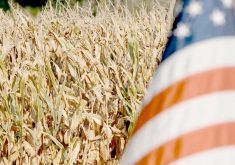WP matchmaker
The Western Producer was the beginning of our love story.
Back in early June of 2003, on a bit of a whim, I took a look through the personal section of your publication.
Being in my early 20s at the time, I’ll admit I did not expect to find anyone close to my age group, but much to my surprise there was an ad listed by a man in his early 30s.
After holding onto the ad for roughly a week, I decided I really had nothing to lose and wrote a letter to him. He responded within a few days and I followed up with another letter of my own.
Read Also

Agriculture needs to prepare for government spending cuts
As government makes necessary cuts to spending, what can be reduced or restructured in the budgets for agriculture?
Our first phone conversation lasted several hours into the night. The first few months of our courtship consisted of letters and phone calls because at the time I was moving from Airdrie, Alta., to Saskatoon and he was living in Swift Current.
Our first meeting took place once I was settled in Saskatoon in September 2003 and the rest, as they say, is history.
Six years later we’re finally together in Swift Current and our wedding is planned for April 2010.
We each have and treasure a framed copy of that ad, which really was the beginning for us.
We both feel so lucky and blessed to have found each other and really must thank your newspaper for bringing us together.
Fate really does work in such strange ways and in this case it brought two farm kids together who perhaps never would have crossed paths if I hadn’t been reading your paper since I was a kid.
– Sharilee Brown,
Swift Current, Sask.
Cattle checkoff
To the chairs of Alberta Beef Producers, I have read many letters on the refundable checkoff that you folks are telling the government that they did a devastating thing by giving the producer say as to if we want our money put into the ABP’s control or not.
I hope I don’t need to remind you that your dollars at the grassroots are coming from nearly broke, aging producers who work full-time jobs to support their habit of ranching…
With our stagnant cattle prices compared to cost of living, I challenge you to buy land, cattle and machinery, set up a place so that it would support you and an average family.
Then see the ABP collect $8 million a year for seven years after BSE, very little in new markets captured and our packing industry in the West turned from three firms to only two and say it is a good thing.
Tagging went mandatory; progress is slow in an industry that is dying fast. We have seen no progress from our five years of tagging except promises of a better tomorrow that seem to never come.
Our provincial government has lost confidence in ABP from the cries of the producers, and at least is trying to come up with new projects that will help, as in the Alberta Livestock and Meat Agency. Hats off. They should not have had to step in if you were doing your job.
Now that the checkoff is refundable, the producers will grade your performance and more importantly, you should grade yourselves. If you earn it, we earn it, and everybody will be happier.
– C. Kuziw,
Coronation, Alta.
Human predators
Neil and Mary Bartsch are absolutely correct as to the demise of their cow (“Scavengers likely mutilated cow,” WP, Aug. 27.)
We lost one with exactly the same damages as their cow. Our cow was nursing a one-month-old calf at the time of her death. We were able to save the calf by feeding it on the bottle.
The loss was in the mid 1970s. She was discovered by a neighbour’s stepdaughter, Kelley Whipple. She and her stepfather, Richard Albers, were moving our cattle to our home pasture that day. Needless to say, it was quite distressing to them.
The human predators came for our cow twice. The eastern edge of our pasture was only about 300 yards from our neighbour’s house. They had two pet dogs, who visited our cattle frequently. I think they were a help in discouraging predators from both our and their owner’s, Raymond and Marguaret Albers’ cattle.
I think the dogs discouraged them the first time. We discovered our bull tangled in the fence.
As Alber’s son Nick was Clearwater County’s sheriff at that time, they may have thought killing the cop’s father’s cow would give them more “devil power.”
There were many such killings during that time. The officials said the same lies then. They didn’t want to panic the cattlemen.
In fact, some packing businesses even sold those parts for profit, I guess. … Yes, Bartschs, I know how you feel. We have had the same experience.
– George Thompson,
Nezperce, Idaho
About monopolies
In the late winter of 1975, our family was having lunch in a Brandon, Man., restaurant. At the table next to ours, three fertilizer executives, two local and one from the U.S., were discussing product pricing and bemoaning the fact that it was “much easier” for producers of potash or phosphate to justify price increases than it was for anhydrous manufacturers, which they were, since the main ingredient of their product was natural gas, which was dirt cheap at the time.
By 1975, encouraged by U.S. government food price controls and … the food prices review board on our side of the border, farm commodity prices had begun a serious downturn after two to three years of almost unprecedented highs and prosperity for farmers.
In an article in the Manitoba Co-operator, a copy of which was lying on their table, farmers, reacting to the price drop, were threatening to summerfallow half their land.
The article appeared to disturb and anger the three and the conversation eventually concluded with, “well, if they (farmers) won’t pay our prices, we’ll grow the grain in China or India.”…
After merging and taking over and buying themselves out over the past three decades, crop buyers and input manufacturer/suppliers have created a marketplace with little or no competition and produced a climate unprecedented in modern times.
Concurrently, these same corporations have, through lobbying and political influence, worked steadily at dismantling the public regulatory systems which, for generations, have afforded producers some protection and manoeuvreability, and are rapidly replacing them with regulations of their own, geared solely, of course, to guaranteeing their own insatiable quest for profit.
Each half-baked government scheme supposedly designed to compensate for some of the damage is less effective than its predecessor.
In a brief presented before the House of Commons Standing Committee on Agriculture June 11, the National Farmers’ Union produced numbers from Agriculture Canada and Statistics Canada that reveal that over the past 24 years, input suppliers, etc. “have captured 99.6 percent of the wealth generated on Canadian land.”
The presentation carried on to state that “Canadian farmers have produced and sold an overall average of $388 per acre per year with farmers being left to make do with just $1.45 per acre per year (overall Canadian average) in the form of net income from the markets – government payments excluded.
“The corporations that provide farm inputs and services – fertilizer, chemical and seed companies, banks – captured the other $386.55 per acre (all figures adjusted for inflation).”
Over roughly the same period, farmers have tripled their exports but farm incomes have been halved and farm debt has skyrocketed.
The math on the size of farm required at net $1.45 per acre per year from the marketplace in order to provide a farmer with a salary that breaks just over the poverty line is beyond depressing.
It is, then, small wonder, when fertilizer suppliers raised prices to astronomical levels over the past year and a half, that farmers took more seriously than usual the little matter of economic threshold and, despite a barrage of threats of shortages, etc., decided to balk…
In general, it looks as if the threat made in the Brandon restaurant all those years ago has materialized, carried out at the expense of Canadian farmers with Canada’s own resource sold into the Asian market at levels far below those charged to Canada’s own farmers.
Fertilizer executives, when looking for someone to blame for possible food shortages, and perhaps crying over spilt bonuses, might take a glance in the mirror….
– Beverly Stow,
Graysville, Man.
















